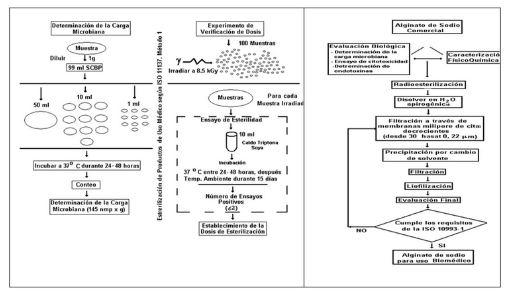Radiomodification of polymeric materials at the Center for Technological Applications and Nuclear Development (CEADEN)
Main Article Content
Abstract
This paper shows some studies carried out throughout these two decades at the Center for Technological Applications and Nuclear Development (CEADEN) in the field of radiomodification and synthesis of polymeric materials through the use of ionizing radiation to obtain polymers by grafting, radiosterilization and purification of a natural polymer: sodium alginate, obtaining a copolymer of 2-hydroxyethyl methacrylate (HEMA) and acrylamide, preparing hydrogel dressings from polyvinylpyrrolidone (PVP) for topical use, with two clinical trials were carried out in hospitals in Havana and CEADEN received the medical record from the Center for State Control of Medications, Equipment and Medical Devices (CEDMED) as a regulatory body, in the end it was describes the production of PVP and PVP-silver nanogels for controlled release.
Article Details

This work is licensed under a Creative Commons Attribution-NonCommercial 4.0 International License.
Aquellos autores/as que tengan publicaciones con esta revista, aceptan los términos siguientes:
- Los autores/as conservarán sus derechos de autor y garantizarán a la revista el derecho de primera publicación de su obra, el cuál estará simultáneamente sujeto a la Licencia Creative Commons Attribution-NonCommercial 4.0 International (CC BY-NC 4.0) que permite a terceros compartir la obra siempre que se indique su autor y su primera publicación esta revista. Bajo esta licencia el autor será libre de:
- Compartir — copiar y redistribuir el material en cualquier medio o formato
- Adaptar — remezclar, transformar y crear a partir del material
- El licenciador no puede revocar estas libertades mientras cumpla con los términos de la licencia
Bajo las siguientes condiciones:
- Reconocimiento — Debe reconocer adecuadamente la autoría, proporcionar un enlace a la licencia e indicar si se han realizado cambios. Puede hacerlo de cualquier manera razonable, pero no de una manera que sugiera que tiene el apoyo del licenciador o lo recibe por el uso que hace.
- NoComercial — No puede utilizar el material para una finalidad comercial.
- No hay restricciones adicionales — No puede aplicar términos legales o medidas tecnológicas que legalmente restrinjan realizar aquello que la licencia permite.
- Los autores/as podrán adoptar otros acuerdos de licencia no exclusiva de distribución de la versión de la obra publicada (p. ej.: depositarla en un archivo telemático institucional o publicarla en un volumen monográfico) siempre que se indique la publicación inicial en esta revista.
- Se permite y recomienda a los autores/as difundir su obra a través de Internet (p. ej.: en archivos telemáticos institucionales o en su página web) antes y durante el proceso de envío, lo cual puede producir intercambios interesantes y aumentar las citas de la obra publicada. (Véase El efecto del acceso abierto).
La Revista Nucleus solo aceptará contribuciones que no hayan sido previamente publicados y/o procesados, por otra publicación. Cualquier violación ese sentido será considerada una falta grave por parte del autor principal lo cual será objeto valoración por parte del Consejo Editorial, el cual dictaminará al respecto.
References
[2] GONZÁLEZ M, GALEGO N, ORTIZ P, RAPADO M. Raman spectroscopy of poly(3-hydroxybutyrate) modified with poly (vinylacetate) by radiation induced copolymeriztion, Nucleus. 2007; (42): 40-44.
[3] RAPADO M, SAINZ D, FERRER A, WANDREY C. Physical-chemical changes in irradiated sodium alginate algimar. Nucleus. 2004; (35): 55-59.
[4] WANDREY C, SAINZ D. Purification of polymeric biomaterials. AnnNY Acad Sci. 2001; 944: 187-198.
[5] United States. FDA guidelines USP. Bacterial endotoxin test. 1991.
[6] RAPADO M, PENICHE C. Synthesis and haracterization of pH and temperature responsible poly(2-hydroxyethyl methacrilate -co-acrylamide hydrogels. Polímeros: Ciencia e Tecnologia, 2015; 25(6): 547-555.
[7] RAPADO M, RODRÍGUEZ A, PENICHE C. Hydrogel wound dressing preparation at laboratory scale by using electron beam and gamma radiation. Nucleus. 2013; (53): 24-31.
[8] GES A, VILTRES H, RAPADO M, AGUILERA Y. Radiation-induced synthesis of polyvinylpyrrolidone. (PVP) nanogels. Journal of Physical Science and Application. 2016; 6(5): 21-26.
[9] GARCÍA RODRÍGUEZ LAURA M, DÍAZ JIMÉNEZ DANIELA,. PÉREZ GUEVARA OL, et. al. Evaluación de la citotoxicidad de nanogeles de polivinilpirrolidona (PVP) en fibroblastos murinos. Revista Biomédica. 2019; 30(3). Disponible en: https://www.revistabiomedica.mx/index.php/revbiomed/article/view/708
[10] KOUL V, KUCKLING D, CHOUDHARY V. Interpenetrating polymer network (IPN) nanogels based on gelatin and poly(acrylic acid) by inverse miniemulsion technique: synthesis and characterization. Colloids and Surfaces B: Biointerfaces. 2011; 83(2): 204-213.
[11] MBHELE Z, SITTERT V, NEDELJKOVIC JM; et. al. Fabrication and characterization of silver polyvinyl alcohol nanocomposites. Chem Mater. 2003; 15(26): 5019-5024.

